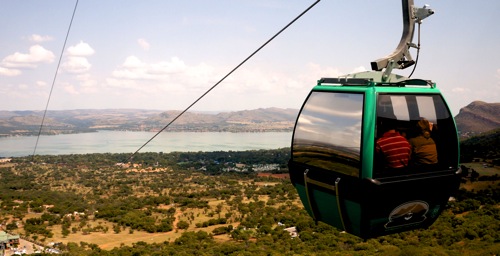30 April 2013
28 April 2013
Jozi walking part 4 - Joburg Places and Spaces
This is part 4 in a series on walking tours of Johannesburg. While other cities also offer guided tours, Jozi is unique in my mind as a place where people will group together, with or without a guide, to visit places that they normally wouldn't. Whether for safety in numbers, unfamiliarity or companionship, it's a thing here.
 |
| Gerald, our tour leader, making a point |
I met Gerald through my friend Heather. He is the author of the definitive Jozi guide - Joburg Places and Spaces 2.0. At long last I get to take part in one of his walking tours around the regenerated CBD. We meet in the current flavour of the month suburb of Braamfontein with its Neighbourgoods Market and the Lomo Gallery as well as an upmarket bike shop. It has everything a city borough needs to attract the better-off hip crowds of Joburg thirsty for new weekend venues: student bars, start-ups and refurbished condos.
 |
| Neighbourgoods Market in Braamfontein |
 |
| Gerald explaining the layout of the CBD |
 |
| The view from Randlords |
 |
| The view from the ladies - no, really! |
We walk down the street to Randlords, one of the many private rooftop bars dotted around the city. The 22nd floor is one great window to the skyline, currently being set up for a wedding of hundreds. There is an elaborate deck with cushioned beds for lounging behind a glass bannister. There is even a swing for the playful-minded. The views south across the railway lines towards Newtown, east over the green suburbs to Brixton tower and the slag heap remnants of the gold mines, west to Hillbrow and the CBD are stunning, giving us a taste of what's to come.
| In the midst of the city |
 |
| Street trader selling peanuts and underpants |
 |
| All the activities that are not allowed on the Rea Vaya |
There is a smart card system in development, but for now we get paper tickets. The clean, new, fast bus (it runs in dedicated lanes through the CBDs grid) takes us downtown to the first of the regenerated areas. The Kerk Street development used to be a rough informal market street, but now has French-style open roofs for the traders and hair braiders stretched along the centre of the pedestrianised street. Both sides are lined with mainstream shops selling fashion like any other shopping street.
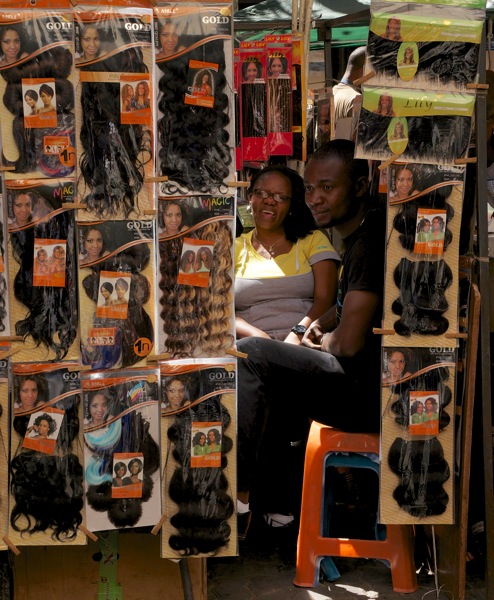 |
| Braiding supply shops |
 |
| Hair braiders on Kerk Street |
| Markham's Department Store |
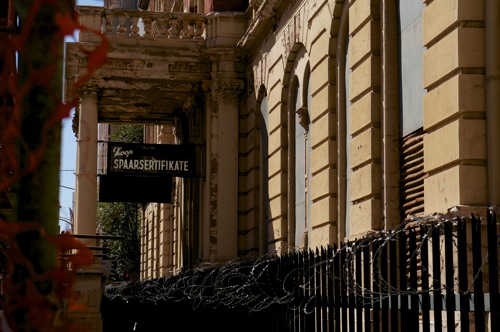 |
| Rissick Street Post Office |
 |
| Another intriguing architectural style, representative of 60s Apartheid paranoia |
'Jozi, you've come a long way. Now let's go even further.'
 |
| Gandhi would approve |
 |
| The regenerated Ernest Oppenheimer Park |
 |
| Chilling on the rooftops |
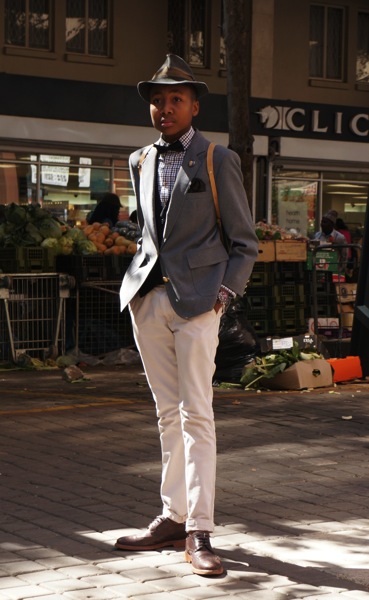 |
| A fashion afficionado in Kerk Street |
You can find more photos in my Flickrstream.
| www.flickr.com |
Labels:
cities,
culture,
johannesburg,
people,
photo,
Photowalking,
South Africa
22 April 2013
An Easter outing
We pick up Heather at 9am. The sun is blazing, the long weekend is upon us, it's time to get out of town. Hartebespoort Dam is easy to get to, so that's our aim for today. Everyone else seemed to have the same idea, so the little town is busy by the time we get there, the main road clogged with visitors. As the closest resort to both Jozi and Pretoria, Hartebespoort consists of holiday homes and retirement communities. It's all very Afrikaans, as Heather points out, although I can't really tell, a white South African looks like another to me.
We have two destinations in mind today, perfect and easily digestible both: the newly renovated cablecar going up the Magaliesberg and the film set of the comedy musical Pretville (Afrikaans link).

The lift cars are small, green and glassed in. They keep moving as passengers get out and in. We have to swap seats to balance each other's weight, then the car slides off with a big whoosh like a fairground ride. Suddenly, at great speed, we are above the car park, and then above the wild hills. Underneath is a thicket of green trees, red earth, yellow rocks. We gain height and the valley unfolds below us. In the distance the green-blue of the dam blazes in the sun. Behind it low hills point the way to Joburg, while to our right and left the eroded slopes of the Magaliesberg step away from us in geometric uniformity. Below me I can make out a thin path winding uphill. Above me the slack lines of the cable connection hold us in the air.
The threesome opposite us, a couple and their lady friend visiting form Cape Town, smile at our excited exclamations at the view. The visitor was not impressed. Having the table mountain cable car on your doorstep, this must be a comedown. I am intrigued: by the sheer cliffs we pass and the trees growing stubbornly out of a tiny crack in the rocks; by the possibility of seeing animals; by the loud fresh green against the harsh dry red soil.
The ride is over too soon, and we step off the moving cart at the top station. A walkway guides us around and up the hill with pointers along the way. It's hot, with children jostling to climb the rocks on the edge of the hill, nervous parents holding on to their hands to prevent fatal falls. Haartebespoort spreads below us in a hot haze. We can just make out the sailing marina, the main road and blotches of retirement estates.
Next we backtrack to Pretville, the film set for a 50s Afrikaans musical. It's an incongruous place, a fake ice-cream coloured confection used to film an all-singing, all-dancing spectacle of history white-washing. While the Group Areas Act was being designed to force families from their homes, the diner served milk shakes and the pharmacy treated babies with colic.
An innocuous-looking police car is parked in the square, dinky and cute. I have the overwhelming sense that it is missing a black offender of the pass laws in the back. The car repair shop lacks an oily labourer, and the tiny prison tucked away behind the children's clothing store really should have been staffed with ANC supporters. The place feels like a lie, all of us white people (unlike the cable car, there are no actual black faces at Pretville) wandering about this movie-glossed version of a reality that never was.
Unlike the photos in a photo book I saw recently, where the poverty of mind and life, the harsh conditions of the Karoo, the wiry stubbornness and hateful relationships with blacks was clear and unmistakeable, here all the issues have just been airbrushed out of the picture. I guess the 50s in South Africa is just not a a historical period that lends itself to bubblegum entertainment.
On the way home, by way of irony, we passed Diepsloot, one of the biggest 'informal settlements' just north of Joburg. This woman was cutting straw from a fallow field across the township to sell as roofing material. No pink here.
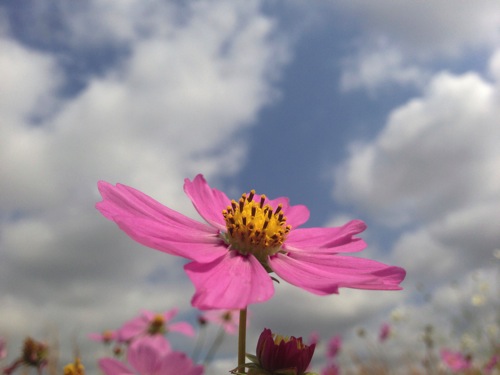 |
| The signs of autumn are upon us |
Hartie's Cable Car
Cable car first, to avoid the after lunch crush. But when we get there, a queue is already building, the car park full of SUVs and bakkies. Stuart gets tickets while we start queuing up the stairs. The lift was built in 1973 with Swiss equipment and know-how, but closed down in the 80's, only re-opening last year. It's a pretty nice renovation, with a few shops and cafes, clean toilets and an organised system to maximise passengers. A ticket collector checks the queue to match groups to always fill each carriage with six people. Everyone is happy to jump the queue. We wind our way up the ramp until we enter the station hall, a big room open at the end where the carriages slide in and out on overhead wires.
The lift cars are small, green and glassed in. They keep moving as passengers get out and in. We have to swap seats to balance each other's weight, then the car slides off with a big whoosh like a fairground ride. Suddenly, at great speed, we are above the car park, and then above the wild hills. Underneath is a thicket of green trees, red earth, yellow rocks. We gain height and the valley unfolds below us. In the distance the green-blue of the dam blazes in the sun. Behind it low hills point the way to Joburg, while to our right and left the eroded slopes of the Magaliesberg step away from us in geometric uniformity. Below me I can make out a thin path winding uphill. Above me the slack lines of the cable connection hold us in the air.
The threesome opposite us, a couple and their lady friend visiting form Cape Town, smile at our excited exclamations at the view. The visitor was not impressed. Having the table mountain cable car on your doorstep, this must be a comedown. I am intrigued: by the sheer cliffs we pass and the trees growing stubbornly out of a tiny crack in the rocks; by the possibility of seeing animals; by the loud fresh green against the harsh dry red soil.
Pretville
 |
| Pretville's hairdresser set |
Next we backtrack to Pretville, the film set for a 50s Afrikaans musical. It's an incongruous place, a fake ice-cream coloured confection used to film an all-singing, all-dancing spectacle of history white-washing. While the Group Areas Act was being designed to force families from their homes, the diner served milk shakes and the pharmacy treated babies with colic.
An innocuous-looking police car is parked in the square, dinky and cute. I have the overwhelming sense that it is missing a black offender of the pass laws in the back. The car repair shop lacks an oily labourer, and the tiny prison tucked away behind the children's clothing store really should have been staffed with ANC supporters. The place feels like a lie, all of us white people (unlike the cable car, there are no actual black faces at Pretville) wandering about this movie-glossed version of a reality that never was.
| the sweet shop |
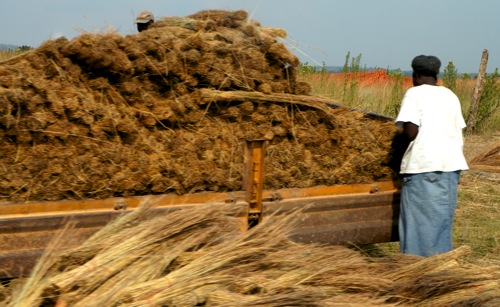 |
You can see more photos on Flickr:
Labels:
architecture,
art,
books,
culture,
films,
friends,
history,
johannesburg,
justice,
people,
photo,
politics,
South Africa,
view
16 April 2013
11 April 2013
Jozi walking part 3 - Instawalking
This is part 3 in a series on walking tours of Johannesburg. While other cities also offer guided tours, Jozi is unique in my mind as a place where people will group together, with or without a guide, to visit places that they normally wouldn't. Whether for safety in numbers, unfamiliarity or companionship, it's a thing here.
We met in Newtown in plenty of time to catch the sunset. Like a clandestine group of spies we gathered in a car park. Roy arrived on his scooter, Alessio drove in from Pretoria, Heather and I from down the road at Melville. It's my first Instawalk. Getting invited was a bit of an effort. True to the spy theme, you have to know someone who nows where and when the meeting takes place, and most important of all, that they even exist. There is no website, no Facebook group, to invitations. I feel like just for once I am in with the in-crowd.
The term Instawalking derives from Instagram, the fabulously popular photo-sharing site. Instagrammers are photographers of every kind, from selfie-shooting narcissists to baby-photo-posting parents, from collectors of urban moments to filter-abusing landscape artists. It's a cultural phenomenon, and since it relies on a smart phone camera, it means that snaps can be posted any time. Some Instagrammers have never used a camera before, some are professionals, most have developed a passion for shooting their life and times.
After a short conversation we decide to move on to Fordsburg to catch the sunset. The other three instagrammers are old hands, so I just tag along. They are looking for the right light, searching always for the un-noticed location, the unusual angle. The urban landscape lends itself to instagramming, so it is no wonder that the thing took off in Jozi, urban centre of gritty urban centres.
Beyond the main street, in the warehousing Asian/Arab suburb of Fordsburg we hit the jackpot. Quiet streets, abandoned store houses, interesting afternoon shadows. As we wander the streets we are quizzed by onlookers. Security guards check us out, shop keepers take our photo as we take theirs, passers-by shake their heads at our interest in their run-down neighbourhood.
Roy has come equipped. With his Ollyclip and his mini-tripod he flattens himself in the middle of the street, perches his camera on a high wall, changes lenses to grab just the right shot. The rest of us make do with the basic iPhone camera (although Instagram also exists for Android, today we are an exclusive iGroup), looking for the unseen behind the street frontages.
Fordsburg is full of unexpected sights: political graffiti on a garden wall, a mural high up above a row of shops, stylish art deco architecture, strange textures where paint has weathered and burnt. People are happy for us to photograph them: the woman on her way home with a baby strapped to her, the man carrying a big roll of fabric on his head, the shopkeeping brothers under their neon lights.
Eventually the sun sets and we retire to Fordsburg market. A bustling centre for the neighbourhood, this Sunday evening it's heaving with families and friends out for an evening of window-shopping and dinner.
The market is squashed into a tiny area between a main road and rows of shops selling glamorous but demure dresses, imaginative head scarf arrangements, shiny shoes and cheap electronics. It reminds me of Satwa, the Dubai neighbourhood most like a real place in that city of gloss and fake. We grab a cup of sugar cane juice freshly made and spiked with pomegranate, consider the many food options and plump for the Afghan chef in a white hat grilling chicken at his tiny stall. The nan bread comes straight out of the portable stone oven and the chicken is mouth-tinglingly spicy. A perfect end to a perfect walk. Let's just hope that I am invited back.
You can find an overview of Jozi walks here, my account of a guided walk in Melville here, a Yeoville walk here and my story of photowalking here.
 |
| There's always one... |
 |
| Afternoon in Fordsburg |
After a short conversation we decide to move on to Fordsburg to catch the sunset. The other three instagrammers are old hands, so I just tag along. They are looking for the right light, searching always for the un-noticed location, the unusual angle. The urban landscape lends itself to instagramming, so it is no wonder that the thing took off in Jozi, urban centre of gritty urban centres.
| The end of the day |
Beyond the main street, in the warehousing Asian/Arab suburb of Fordsburg we hit the jackpot. Quiet streets, abandoned store houses, interesting afternoon shadows. As we wander the streets we are quizzed by onlookers. Security guards check us out, shop keepers take our photo as we take theirs, passers-by shake their heads at our interest in their run-down neighbourhood.
 |
| Fully equipped instagrammers |
Roy has come equipped. With his Ollyclip and his mini-tripod he flattens himself in the middle of the street, perches his camera on a high wall, changes lenses to grab just the right shot. The rest of us make do with the basic iPhone camera (although Instagram also exists for Android, today we are an exclusive iGroup), looking for the unseen behind the street frontages.
| Fordsburg public art |
| winter is coming |
| Time for tea |
 |
| hijab fashions |
Labels:
art,
johannesburg,
photo,
Photowalking,
South Africa,
view,
walking
05 April 2013
04 April 2013
Instagramming about home
A few days ago my friend Heather challenged me on Instagram. The social photo network has recently become my home for image creativity. I still publish my photos on Flickr, but Instagram is more fun, with a better community and wider reach amongst my friends. It's where my pictures have an audience.
So what's an Instagram challenge? Well, after shooting, editing, filtering and sharing the first few hundred photos, Instagram can become a little same-y. So apart from taking Instawalks (more on that next week), Instagrammers challenge each other to shoot photos on a certain theme. Heather's theme for me, quite innocently chosen, was 'at home'. She tells me she imagined that I would photograph pretty still lives around the house. Maybe a view from the terrace (it's a great view). Little did she know that her theme would throw me into full-on retrospective mode. Here are the results, with my comments, as the photos are more symbolic than pretty:
Shot one of my latest #5shotchallenge with the theme of #athome. This is my writing setup at my favourite cafe. It's as much my home as anyplace ever is.
I do spend my most productive days in cafes. Despite a good desk, a comfy sofa, and few distractions, the place where is sleep and eat is not the most conducive for writing. Since my work is who I am, where I work must be where I belong, right?
Shot two of my @5shotchallenge on a theme of #athome. Packing to move house is my way of cutting down on the clutter. Time to travel again, to make another place my home.We move house multiple times a year. Some years we have a steady base, but others we seem to be constantly on the move. Packing suitcases, choosing what to take and what to put into storage is becoming ever easier. Right now we are just changing accommodation for our last month is Johannesburg, so the process is pretty painless. Still, I have trouble thinking of this place, or the last one, or the one before that, as home. The few possessions I cart around, the data on my laptop and the few cherished items of jewellery, the odd knock-knack and the essential camera gear - those embody home more than the actual location they are stored in.
Shot three in my #5shotchallenge on a theme of #athome - every morning, wherever I am, as if by magic, a cup of tea appears by my bedside. #stuartrulesAnd here is the real deal. The routine, the daily habits, the things we do together, those are the moments where I feel I belong. Wherever I am, I have learnt, my habits don't change. I used to imagine that if I were just in this other, better, place, then I could be a better person. I have realised that location is largely irrelevant. Who I'm with, what I do, not where I am, is what matters.
Shot four of my @5shotchallenge on the theme of #athome - this is not my home literally, but since we are Easter egg hunting together, and eating, laughing, chilling together, my friends are where I belong today.Who I'm with, indeed. Just last weekend, leaning back in my chair during an Easter brunch with friends, I had a moment of utter contentment at spending time hanging out with some nice people. I have friends all over the place, which makes it sometimes hard to keep up. So being able to be in the same place with a few of them is a pleasure. Virtual connections help, like Facebook, email, Skype. Nothing beats a communal Easter egg hunt, though.
Last shot in my @5shotchallenge on a theme of #athome - I've been trying to think of the least cheesy way to say this, but there is really no way to avoid this: I am his home and he is mine.'Home is where the heart is', they say. I have nothing to add.
Labels:
ex-pat,
friends,
nomad,
South Africa,
Stuart
01 April 2013
Jozi walking part 2 - Melville walk

We meet at Nel's house in a quiet cul-de-sac off already quiet 4th street. We are only six, this being Nel's first walk after a long hiatus. Nel is a retired history lecturer, having taught the 'History of the Struggle' at Soweto university. She starts with an introduction to Melville:
“This is one of Johannesburg's oldest neighbourhoods. It has ten streets and eleven avenues on a hilly grid. The land was given by the philanthropist Louwrens Geldenhuys, who owned the Braamfontein farm. The suburb was named after Edward Harker Vincent Melville, the surveyor. The developer created a lot of small stands, mainly bought by Afrikaaner manual workers who had been displaced by the British scorched earth policy during the Anglo-boer war. These people didn't have much bargaining power, they were unskilled farmers.”
These were not the large stands of some other suburbs that boasted stables and farm land, Nel points out, but small plots right up to the street.
As we wander up 4th Street, Nel points out what she calls 'catapult trees'.
“Melville was developed before the advent of electricity in Joburg. When power lines were put in the trees were in the way. Instead of cutting them down they were trained to grow on either side of the cables. Unfortunately often one branch grows stronger than the other and the weaker branch breaks off eventually, making for many lop-sided trees."
 |
| A Cape Dutch house fronted by a catapult tree |
Our first stop is the Melville Kruisgemeente church (a Dutch Reformed church), a large red-brick building with accompanying hall. The church is built in the 20s in the Art Deco style on the site of an earlier church hall from 1913, the first of three Dutch reformed churches we are to visit on this tour.
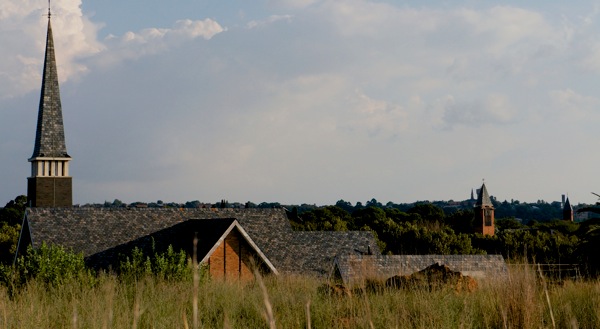 |
| Melville spires - How many can you count? |
“President's Hall.”Eh? Nel explains:
"Until 1961 we were a Crown colony, so everything was called Royal this and that. After 1961 we became a republic. Since then it's President's this and that instead.“
Shows what little knowledge of South African history I have.
We cross the road to walk past the simple white hall of the Methodist church, built to accommodate an alternative flavour of Christianity primarily patronised by the English. This style of simple long building, unadorned and plain, makes it easy to imagine the uncomplicated lives people lived here. Nel tells us about the way that churches and schools were the centre of the community, where people would meet each other, where events were organised and the community formed.
 |
| The entrance to Melpark primary school |
"It used to be that when you had children, you would meet the other mothers at the baby clinic, then again when they went to the primary school together. It meant that you could get together, get support and help. Now the white kids go to the private schools in Linden and Emmarantia and the kids that go to the Melville schools are bussed in from Soweto. There is no local connection anymore. It started when the number of children dropped in the 80s.”
 |
| Painted wall at Melpark school |
Nel explains. The Afrikaans speaking school (Melpark) and the English speaking school (Foundation - we visit it later on 1st Avenue) merged for lack of students. When the schools opened to all races in '94, black children preferred the English-speaking school over Afrikaans-speaking teaching.
“Eventually the Afrikaans-speaking children moved to other schools where their language was given more emphasis, and eventually the English speaking white kids were moved out to other schools as well. Now there are no white children in the two school.”
 |
| Children's names on the Foundation school's wall |
Walking further up 4th Street we admire some of the old-style Melville houses, their simplicity with a green corrugated iron roof, a covered stoop furnished with a sofa, a table, some plants in pots. Many houses up here are not hidden behind a high wall, so we can peek into front gardens, some of them ingeniously decorated with flags, cacti, gravel paths, a cat.
We have reached 1st Avenue, with its second primary school, a neat little art deco brick building fronted by a cleanly-swept playground. The wall bordering the playground is decorated with the names of the kids, all written out in their own hand, some scrawled, some neatly printed: Jason, Johann, Grant, Ambrose, Francois, Marie, Jikk… Amongst the names exhortations to 'Smile!', 'Be Happy', green stars and red hearts.
“The suburb of Auckland Park starts in the middle of this road,”Nel points out
“but that is disputed by some, just like the borders to Emmarantia and Westdene.”
Melville is a desirable neighbourhood now, so everyone wants to be in it.
 |
| Deco elements gone wild |
We follow 1St Avenue to 7st Street, walking past a series of quaint houses, one so stuck full of plaster decorations and fake Victorian cast iron frippery, it is hard to see the house underneath. The owners run a reclamation company and the house looks like whatever they couldn't or didn't want to sell, they stuck to the walls. Another house is an immaculate reconstruction of the colonial houses we saw in Matjesfontein, down to the sweeping metal roof topped with fine cast iron lace edges and filials. Another, much extended, property is clad in dark wood planks to look like a home straight from the Bavarian hills, window shutters, gables, doors and all. It is only missing the geranium flower pots to complete the picture.
We stop again on the corner of 7th and 4th, Nel pointing out the Scala barber shop that has been here for 45 years, and the butcher (Fresh Meat) that closed a while back, which used to deliver a daily order, with all accounts settled at the end of the month. The book shop next door to the butcher - Out of Print Books - has recently moved to 44 Stanley, and is still going strong.
 |
| One more church steeple |
Nel's walk through Melville takes place once a month on a Sunday. You can reach her by email. Nel also arranges personal tours to Soweto and Pretoria.
Labels:
analog life,
architecture,
art,
johannesburg,
Melville,
South Africa,
walk
Subscribe to:
Posts (Atom)


